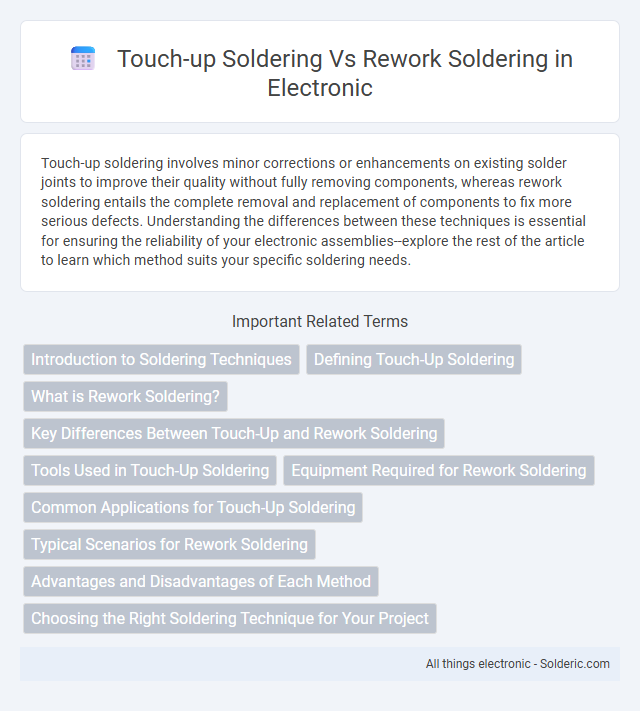Touch-up soldering involves minor corrections or enhancements on existing solder joints to improve their quality without fully removing components, whereas rework soldering entails the complete removal and replacement of components to fix more serious defects. Understanding the differences between these techniques is essential for ensuring the reliability of your electronic assemblies--explore the rest of the article to learn which method suits your specific soldering needs.
Comparison Table
| Aspect | Touch-up Soldering | Rework Soldering |
|---|---|---|
| Definition | Minor correction of solder joints on PCB | Removal and replacement of components on PCB |
| Purpose | Fix small solder defects or bridges | Repair or replace faulty/damaged components |
| Scope | Localized, minimal solder application | Comprehensive component-level work |
| Complexity | Low - simple touch-ups | High - requires desoldering and resoldering |
| Tools Used | Soldering iron, solder wire | Rework station, soldering iron, solder wick, flux |
| Time Required | Short, quick fixes | Longer, component removal & replacement |
| Risk of Damage | Low | Moderate to high |
| Application | During assembly or inspection | Post-assembly repair or modification |
Introduction to Soldering Techniques
Touch-up soldering involves small corrections or enhancements on specific solder joints to improve connection quality without disturbing the entire assembly. Rework soldering refers to the process of removing and replacing defective components or correcting major soldering defects on a printed circuit board (PCB). Both techniques utilize precise temperature control and soldering tools to ensure electrical reliability and mechanical strength in electronic manufacturing.
Defining Touch-Up Soldering
Touch-up soldering involves making minor corrections or enhancements to solder joints on printed circuit boards (PCBs) without removing the components, ensuring electrical connectivity and mechanical stability. It typically addresses issues like insufficient solder, small bridges, or cold joints, improving overall circuit reliability with minimal disruption. This technique contrasts with rework soldering, which often requires component removal and replacement, making touch-up soldering a more efficient solution for localized solder joint repairs.
What is Rework Soldering?
Rework soldering involves the removal and replacement of components on a printed circuit board (PCB) to correct defects or update parts, ensuring proper functionality and reliability. It requires precise temperature control and specialized equipment to avoid damaging the PCB or adjacent components. Your ability to perform effective rework soldering is crucial for maintaining high-quality electronics assembly and reducing waste.
Key Differences Between Touch-Up and Rework Soldering
Touch-up soldering involves minor corrections and small repairs on a printed circuit board (PCB), typically targeting a single joint or a few solder points without removing components. Rework soldering requires more extensive processes, including removing or replacing components, correcting defects, or fixing significant assembly errors on a PCB. Your choice between touch-up and rework soldering depends on the scope of repair needed, with touch-up being faster and less invasive, while rework is more comprehensive and labor-intensive.
Tools Used in Touch-Up Soldering
Touch-up soldering primarily uses precision tools such as fine-tip soldering irons, solder wire, flux pens, and small tweezers to correct minor soldering defects or add small amounts of solder without disturbing the surrounding components. These tools provide controlled heat and accuracy essential for delicate repairs on printed circuit boards (PCBs). Ensuring you choose the right soldering iron wattage and quality flux can greatly enhance the effectiveness of touch-up soldering tasks.
Equipment Required for Rework Soldering
Rework soldering requires specialized equipment such as hot air rework stations, infrared preheaters, and precision soldering irons to safely remove and replace components without damaging the PCB. In contrast, touch-up soldering typically uses basic soldering irons and minimal tools primarily for correcting minor solder joint defects. The precision and temperature control capabilities of rework soldering equipment ensure effective component removal and reattachment, critical for maintaining circuit board integrity.
Common Applications for Touch-Up Soldering
Touch-up soldering is commonly used in repairing small defects on printed circuit boards (PCBs), such as fixing cold joints, bridging solder pads, or replacing damaged components without disturbing the surrounding area. It is ideal for fine-tuning or correcting soldering imperfections in high-density electronic assemblies where precision is critical. This technique ensures minimal thermal impact, preserving the integrity of adjacent components and delicate circuitry.
Typical Scenarios for Rework Soldering
Rework soldering is typically performed in scenarios where defects such as cold joints, lifted pads, or misaligned components occur during the initial assembly process and require correction without replacing the entire PCB. It is essential in repairing complex multi-layer boards or high-density integrated circuits where precision and minimal thermal impact are critical. This process ensures reliability by restoring electrical connectivity and mechanical stability in critical circuit areas.
Advantages and Disadvantages of Each Method
Touch-up soldering offers precise correction for minor defects without disturbing adjacent components, reducing risk of damage and requiring minimal time and materials. However, it may not fully resolve complex faults or extensive PCB issues, limiting its effectiveness in comprehensive repairs. Rework soldering allows complete removal and replacement of components, ensuring thorough correction of faults but involves higher risk of thermal damage and increased labor and equipment costs.
Choosing the Right Soldering Technique for Your Project
Touch-up soldering is ideal for minor corrections and small-scale adjustments, offering precision without dismantling the entire assembly, while rework soldering is suited for extensive repairs or component replacements that require desoldering and resoldering. Selecting the right soldering technique depends on project complexity, component sensitivity, and desired outcome; touch-up provides efficiency for quick fixes, whereas rework ensures thorough repair but demands more skill and time. Evaluating factors like circuit board layout, component size, and thermal tolerance helps determine the most effective approach to maintain product reliability and performance.
touch-up soldering vs rework soldering Infographic

 solderic.com
solderic.com